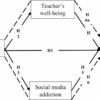Published
September 24, 2024
Social media is becoming ever more important for direct retail of beauty products, and beauty in general continues to boom with the ‘lipstick effect’ still key, a new Barclays Consumer Spend report has shown.

And its data shows that health & beauty “has consistently outperformed broader non-essential spending since the start of 2023”.
In fact, “health & beauty has been the highest-performing category in an otherwise challenging retail sector since August 2023,” Barclays said.
This August, consumer spending on health & beauty was up 7.3% year-on-year – the highest level since January 2023 (10.2%), compared to retail as a whole, which was up 0.1%, and non-essential spending, which was up 0.7% overall.
That’s good news for the beauty industry. But the bad news for the fashion sector is that “in a bid to prioritise spending more on health & beauty, 23% say they have been cutting back on clothing and accessories purchases, which is supported by Barclays transaction data showing clothing was down 1.7% last month”.
It added that a potential reason for health & beauty outperforming broader non-essential spending is that, “while these purchases are technically regarded as non-essential, recent Barclays Consumer Spend research data shows that nearly half (46%) of consumers say they consider them as “essential” – a category which typically includes priority purchases such as groceries and childcare”.
The most resilient products over the past three years – those where consumers say they’ve either increased or not changed their spending – include haircare (66%), bodycare (62%) and fragrances (54%).
As for social media beauty spend, Barclays said that demand for fragrance dupes via social channels remains strong as Britons look to save money without compromising on quality.
Also, alternative “high-quality, affordable beauty products” are on the rise as Beauty Pie memberships continue to grow even through rising living costs.
As mentioned, dupes are proving popular with 32% of consumers saying that they’re buying them due to the rising cost of living. Fragrances have emerged as the most sought-after health & beauty dupes, with 28% of dupe-buyers admitting to spending on imitation scents. Make-up and beauty products are also popular with 24% and 21% of shoppers opting for these. But 18% still prefer to spend money on the original product rather than a dupe.
Barclays said that the number of shoppers buying fragrances on social media overall has grown from 12% to 17% – the largest increase of any health and beauty product. Similarly, there’s also a growing demand for beauty and skincare products (24% to 27%), and haircare (14% to 16%).
Meanwhile, since January alone, the number of consumers watching de-influencing videos to find out which products aren’t worth buying has climbed sharply (from 11% to 17%).
And 22% say they discover new beauty trends via social media, so it’s no surprise that beauty and skincare are among the most popular products, with 27% saying they’ve bought these products on social media.
But a plus for physical stores is that in-store spending remains a vital part of the shopping experience. Some 56% of shoppers, say they prefer to buy health & beauty products that they’ve never used before in-store. Consumers are however more comfortable making repeat purchases online (24%), than they are first-time purchases (18%).
Copyright © 2024 FashionNetwork.com All rights reserved.



